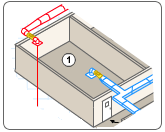|
 
Lab IntroductionIn this room, the volume of air required varies along with the thermal demand from the peak thermal load down to the minimum ventilation rate for the space. The operating savings achieved by varying the volume from this space quickly compensates for the added cost of making this a variable volume zone. Sequence of OperationsIntroductionPhoenix Controls venturi air valves can be used to a net negative or positive pressure relationship between critical use rooms and an adjacent corridor or room. Such pressurization controls are typically applied in clean rooms, special process areas, hospital operating rooms and in rooms without fume hoods within laboratory facilities. In this application, the zone's pneumatic thermostat controls both the supply valve and the reheat coil to provide temperature control. A slave supply valve (MAV) is used to control the supply air volume entering the zone. The minimum supply volume is sized to satisfy the ventilation rate (calculated from air changes per hour) and the maximum supply volume is sized to satisfy the maximum thermal load. The general exhaust (GEX) volume leaving the zone is controlled with an exhaust valve (EXV). The GEX valve tracks the supply air volume plus the desired net negative room offset volume or minus the positive room offset volume to maintain zone pressurization control. Rising Zone TemperatureOn a rise in zone temperature, the electronic thermostat [or DDC controller] shall send a thermal demand signal to the supply air valve that is within a 0 to 10 Vdc range. This thermal demand signal shall be proportionate to the supply air volume required to condition the zone. Pressurization ControlIf a negative room offset volume is desired, the M option (a scaling function module mounted on the general exhaust valve) shall add the quantity of offset to the supply valve's feedback signal. [If a positive room offset volume is desired, the offset quantity shall be subtracted from the supply valve's feedback signal.] The resultant 0-10 Vdc signal shall command the general exhaust valve, thereby providing pressurization control of the zone. Dropping Zone TemperatureOn a drop in zone temperature, the thermostat signal shall decrease in magnitude until the supply and general exhaust valves are in their minimum scheduled positions as listed on the room schedule sheet. On a further drop in zone temperature, the thermostat signal shall open the control valve serving the reheat coil. Static Pressure FluctuationsAs the static pressure in the exhaust and supply duct systems fluctuates, the pressure independent cone/spring assembly of each Phoenix venturi valve shall modulate to maintain a fixed set-point volume within one second. Fail-safe ConditionThe valves in this application have been configured to fail in the following manner. Under loss of pneumatic air or power, the general exhaust valve will fail to its maximum mechanical limit, and the supply valve will fail to its minimum scheduled position. This zone fails in a negative pressurization mode with an increased offset volume. |
  |
||||||
| HOME | MARKETS | PRODUCTS | SERVICES | CASE STUDIES | INCENTIVES | ABOUT US | ||||||
|
||||||
| HOME | MARKETS | PRODUCTS | SERVICES | CASE STUDIES | INCENTIVES | ABOUT US | CONTACT US | SITE MAP ©2007 All rights reserved. Newmatic Engineering. Website by SR Designs. |
||||||
